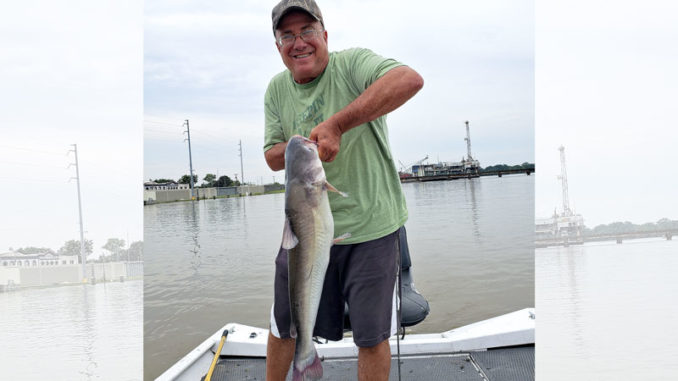
Just drop a river shrimp in the Atchafalaya River in Morgan City for the next 10 weeks and you’ll have blue and channel catfish burning a hole in your ice chest.
Bill McCarty’s main goal on some of his favorite fishing trips from mid-April through June is to make catfish happy.
When they’re happy, this avid, all-around outdoorsman is happy.
Minutes after anchoring his aluminum boat in the Atchafalaya River about 80 yards from the Morgan City floodwall, parallel to the large “M” in the MORGAN CITY and directly upstream from the third leg of the Mr. Charlie, the oil-field rig museum, McCarty pried the lid off a round plastic container and dumped frozen river shrimp into the swift water.
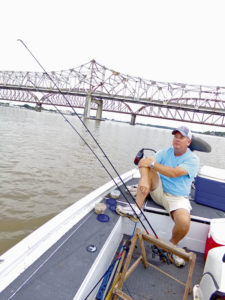
“The first thing I’m going to do is chum. You’ve got to make the catfish happy,” said McCarty, a 50-year-old Morgan City native who was practically rubbing his hands in anticipation of the catfish-catching bonanza that rarely fails to materialize when catfish are in the lower end of the river, several miles upstream from where it empties into the Atchafalaya Bay.
His routine is borne of years of experience, almost guaranteed to produce.
McCarty’s routine
First, McCarty unfolds and sets up on the floor of his boat a custom-built wooden rack — his uncle, Al Belaire of Morgan City, built it — that has notches for five fishing rods. Then, he readies five identical 6-foot-6 Shimano Sojourn rods with matching Daiwa RG reels spooled with 15-pound Trilene Big Game mono tied to a 1/0 Gamakatsu offset shank hook under a 2-ounce bank sinker. About 10 inches above the weight, he doubles the line to make a loop for a 6- to 8-inch leader, which keeps the shrimp off the river’s bottom.
His routine is nearly finished. He always pulls out two “fish towels,” one for him and one for a fishing guest, to wipe the slime off after handling so many blue and channel catfish.
McCarty impales two river shrimp on each hook on four of the fishing rods and shows a visitor to his boat how it’s done. He catches the shrimp himself in wire-mesh traps he strategically places in spots downriver along the flooded shoreline. Otherwise, river shrimp can be purchased by the pint at D&B Seafood and Convenience Store, he said, or at residences in Morgan City, mainly along Second Street, which bear signs that read “River Shrimp for Sale.”
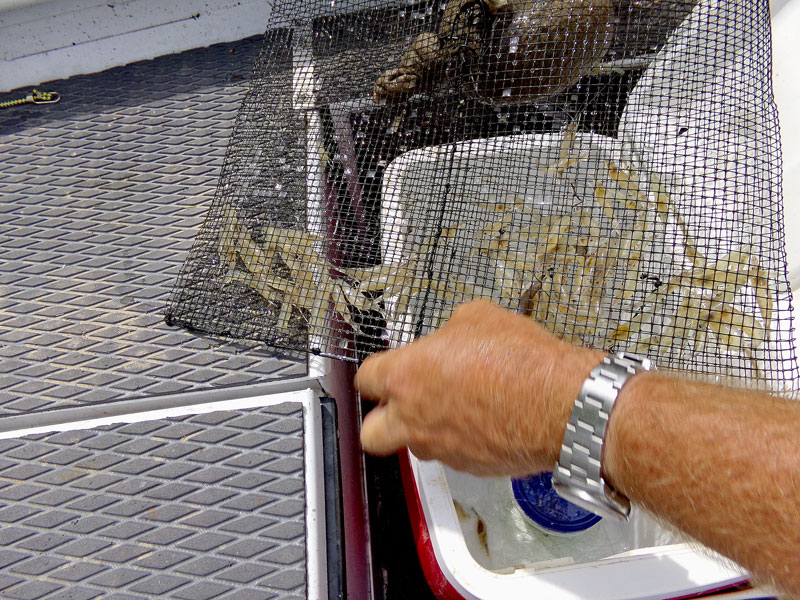
“I always put two shrimp on, one at the top of the hook and one at the bottom. When a fish hits the first one, he has to hit the second one,” McCarty said.
A great combo
A 2-ounce bank sinker and hook baited with two shrimp are an unbeatable combination. Then, and only then, is it time to cast into the high and muddy water on a partly cloudy morning at the height of the spawning period. He uses two rods, and his fishing buddy uses the other two. The fifth is a spare, which is needed because backlashes are common — the visitor eventually backlashed one of the reels so badly it took two days to unravel.
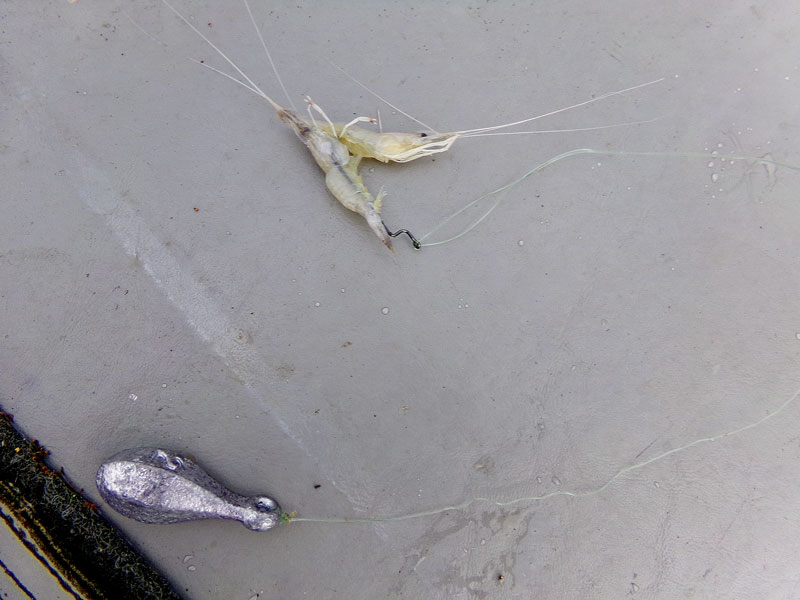
To keep the lines from tangling, he advises anglers to cast one rod directly behind the boat, the other at a 45-degree angle to the left and behind the boat. He fished the other side similarly.
Game on. He described what the bites would be like and when to set the hook.
“Don’t set the hook on the first bump, but be ready, because he is coming back. Soon as you feel the second half tap, set the hook. Hard,” McCarty said.
The river shrimp, bumping around on the bottom, 15 to 17 feet deep, got the desired result within minutes. He picked up the rod, waited, then set the hook hard and reeled a 1½-pound channel catfish in against the swift current.
It was the first catfish to hit the ice chest. Within a few hours,there were 45.
The right spot
Usually, McCarty gets on the water about 7:30 a.m. after launching his boat on the Berwick side of the river about 45 seconds away from his sweet spot. Most of the time, he has 40 to 80 blues and channels, ranging from 1 to 2½ pounds, with the occasional 8- to 10-pounder, and is back home before 10 o’clock.
He learned how to fish that particular spot from his wife’s uncle, the late Sonny Billiot of Morgan City, who took him on catfish trips during his college days at LSU.
“(He) showed us how to do this. He’s gone now, but he could catch some catfish,” McCarty said.
When he was younger, he tied up to the railroad bridge near the shoreline and dropped his lines in the river, which in April is usually above 4.0 feet at the Morgan City gauge.
On the day he and his fishing buddy caught 45, he was the first one fishing that area.
“Sometimes, when it gets good, and the word gets out, and it’s easy to get to, there’ll be 15, 20 boats. A lot of people go farther upriver, to (Conrad Shipyard) and (Candy Fleet Corp.),” he said.
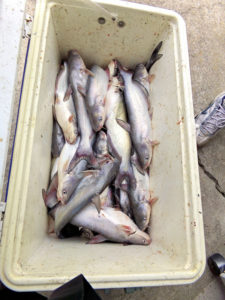
About 15 minutes after he started fishing, two more small boats idled into the area from upriver and anchored just below the railroad bridge near the Mr. Charlie. Anglers in a crawfish skiff arrived an hour later, and soon, another small boat anchored several yards upriver of the railroad bridge and 90 yards from shore.
Mid-April to mid-June
The catfish run starts in mid-April and usually is over by mid-June, unless the river stays unseasonably high, like it did well into last summer. You know it’s over when the river drops like it does at some time during the summer, McCarty said.
“It usually stops when crabs come up the river. They’re aggravating,” said McCarty, who sometimes goes on evening trips.
There’s a special treat, lagniappe, for all who go on late afternoons in that area near the floodwall. Café Jo Jo’s on the 600 block of Front Street has live music — old country, swamp pop, Cajun rock — on Friday evenings from mid-April into June. The musical notes waft over the river and across the city during each Rhythms on the River event.
“That’s definitely a neat deal. You can sit on the river, drink ‘pop rouge’ and listen to swamp pop and catch catfish. It’s fun,” McCarty said.
It isn’t unusual to catch two, even four catfish at a time, any time of the day. If there are simultaneous bites, McCarty sets the hook on each and judges how heavy each hooked catfish is, then brings in the heaviest first.
“We did five (at one time) yesterday,” McCarty said.
The action can be fast and furious, exciting as all get-out. It there are lulls, that’s a real good time to strike up conversations about sports, politics, the family, you name it, and enjoy being on the water.
It’s also a very good time to count the number of catfish that come over the side of the boat and get deposited in the ice chest. His wife and daughter are accustomed to it.
“They don’t like the ‘score tracker update’ as we compete,” he said.
Bonus fish
Don’t be surprised to catch species other than catfish. Plenty of fish want to dine on local river shrimp.
Gaspergoo (freshwater drum), stingray, gafftop catfish and even sturgeon have been boated in the past. Yes. Sturgeon.
“A buddy of mine caught a sturgeon about three weeks ago. It wasn’t a big one, probably about 3 pounds,” he said.
If you doubt the power of river shrimp, McCarty will prove you wrong. Sometimes a fishing buddy he takes along argues that he can catch all the catfish he wants on something other than river shrimp. One of his friends once confidently brought hot dogs, but the river shrimp outfished them 5 to 1. Saltwater bait shrimp don’t hold a candle to river shrimp, either.
Those native crustaceans can be used frozen for a long period or freshly frozen, but never alive, because it seems the longer they stay in a covered plastic container, the more they smell and become firmer, which helps them stay on the hook, according to McCarty.
And, of course, they are “cute.”

